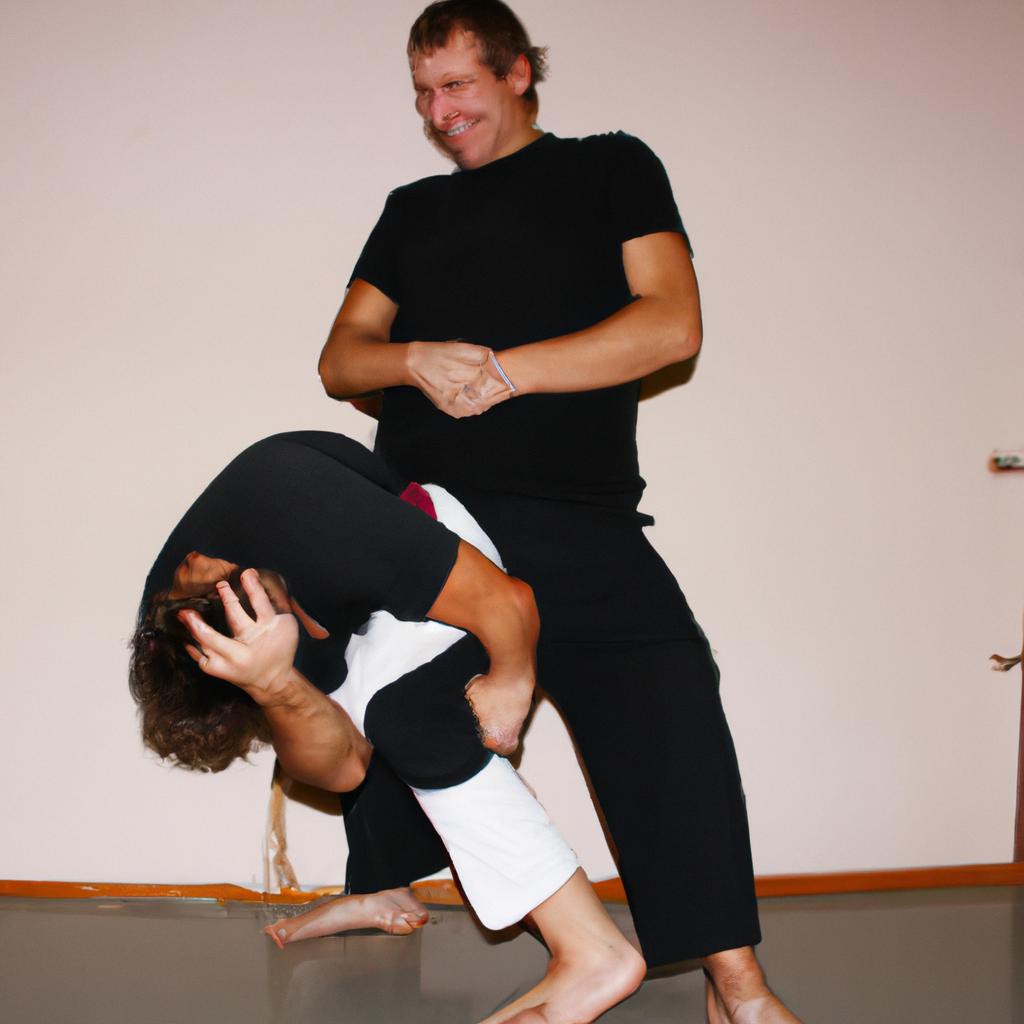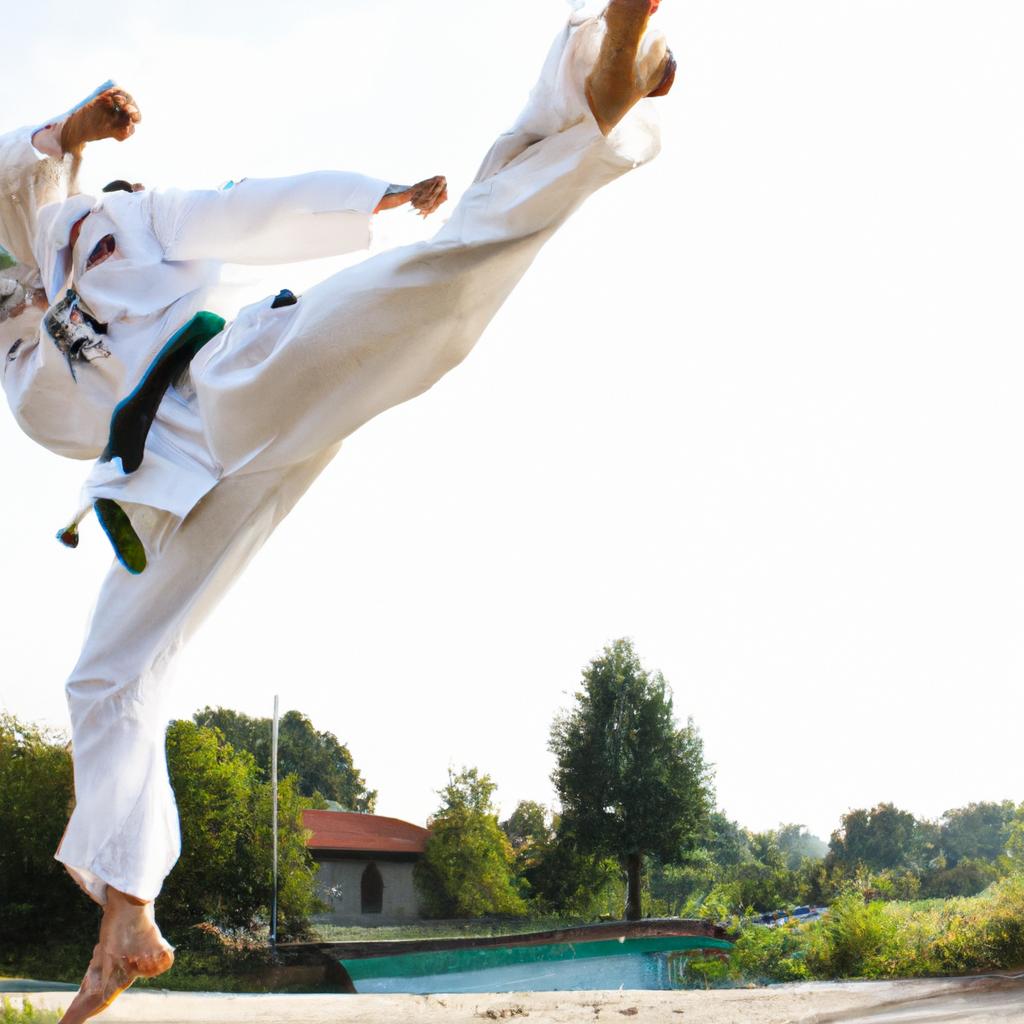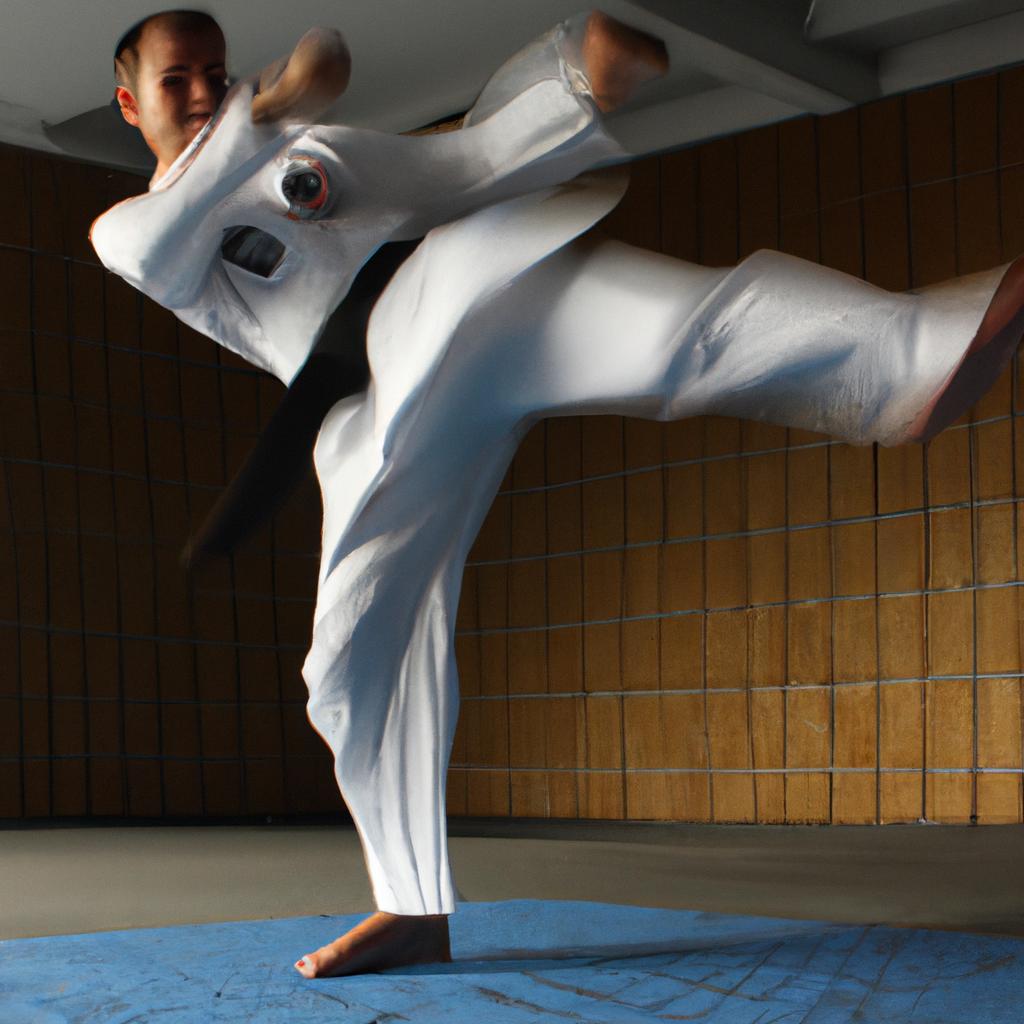Self-defense is a fundamental aspect of martial arts, and Mixed Martial Arts (MMA) has emerged as a popular combat sport that incorporates various techniques from different disciplines. Among these disciplines, Taekwondo stands out for its emphasis on kicks and strikes, making it an intriguing domain to explore in the context of self-defense. This article aims to delve into the self-defense techniques employed in MMA through the lens of Taekwondo, examining their effectiveness and applicability in real-life situations.
Consider a hypothetical scenario where an individual finds themselves confronted by an assailant on the street. In this situation, the ability to defend oneself becomes paramount. While traditional martial arts often focus on rigid forms and strict protocols, MMA combines multiple styles to create a more comprehensive approach to self-defense. Within this framework, Taekwondo brings forth unique elements such as dynamic kicks and fluid movements that can prove advantageous when faced with unexpected attacks. By examining how Taekwondo principles are applied in MMA’s self-defense strategies, we can gain insights into the practicality and adaptability of these techniques within real-world scenarios.
With the rise of mixed martial arts competitions worldwide, there has been increased scrutiny surrounding its effectiveness beyond the ring or octagon. Critics argue that certain moves Critics argue that certain moves or techniques used in MMA may not be practical or effective in real-life self-defense situations.
Understanding the Concept of Self-Defense
Imagine a scenario where an individual finds themselves walking alone at night, when suddenly they are approached by a stranger who appears to be behaving aggressively. In this situation, the person’s natural instinct might be to protect themselves and ensure their safety. This innate response is what we refer to as self-defense – the ability to defend oneself from harm or danger.
When exploring the concept of self-defense, it is essential to recognize that it encompasses various techniques and strategies aimed at preserving personal safety. These methods can vary depending on factors such as martial arts training, physical fitness, and situational awareness. To further understand its significance, let us consider some key points:
- Physical Empowerment: Engaging in self-defense practices allows individuals to develop physical skills that empower them to handle potentially dangerous situations more effectively.
- Mental Preparedness: By learning self-defense techniques, one gains confidence and mental preparedness, enabling them to think clearly under stress while making quick decisions.
- Personal Safety Awareness: Self-defense training fosters increased awareness of potential threats in one’s surroundings, promoting proactive measures for avoiding confrontations whenever possible.
- Emotional Resilience: The practice of self-defense not only enhances physical strength but also builds emotional resilience, allowing individuals to better manage fear and anxiety during critical moments.
To delve deeper into understanding self-defense within the context of Mixed Martial Arts (MMA) and Taekwondo specifically, we will explore key principles in subsequent sections. Through comprehensive analysis and practical examples, we aim to shed light on effective techniques that can be utilized for personal protection.
In transitioning towards examining the fundamental principles of self-defense in MMA, it is crucial to grasp the underlying concepts involved in these combat disciplines. By doing so, individuals can gain insight into how different strategies are applied within specific contexts and adapt them accordingly for their own personal safety needs.
Key Principles of Self-Defense in MMA
Having established a foundational understanding of self-defense, we now delve into the key principles that underpin the effective application of self-defense techniques within Mixed Martial Arts (MMA). To illustrate these principles, let us consider a hypothetical scenario where an individual finds themselves confronted by multiple attackers.
In this hypothetical situation, imagine you are walking alone at night when suddenly, four individuals approach you with hostile intent. As they encircle you, it becomes clear that escape is not an option. This example highlights the crucial importance of adopting strategic and practical methods for self-defense.
To increase your chances of survival and minimize harm to yourself, several key principles should guide your actions:
-
Awareness and Preparedness:
- Stay alert and be aware of your surroundings.
- Assess potential threats or vulnerabilities.
- Maintain proper body positioning to react swiftly if needed.
-
Effective Striking Techniques:
- Utilize strikes targeting vulnerable areas such as eyes, throat, groin, or knees.
- Employ precise and powerful strikes to incapacitate opponents quickly.
- Combine striking techniques from various disciplines like boxing or Muay Thai.
-
Tactical Footwork and Movement:
- Use footwork to maintain distance from attackers.
- Create angles to avoid being surrounded or overwhelmed.
- Move strategically to gain positional advantage over assailants.
-
Adaptability and Quick Decision Making:
- Continuously assess the evolving situation during an altercation.
- Modify tactics based on changing circumstances.
- Make split-second decisions regarding when to defend, counterattack, or disengage.
By adhering to these fundamental principles, individuals can enhance their chances of successfully defending themselves in an MMA context or any self-defense scenario.
Table: Techniques for Self-Defense Situations
| Technique | Description |
|---|---|
| Eye gouging | Targeting the eyes with fingers, knuckles, or thumbs to disable attackers’ vision. |
| Knee strikes | Employing knee strikes directed at vulnerable areas like groin, abdomen, or face. |
| Elbow strikes | Utilizing powerful elbow strikes to inflict damage on close-range assailants. |
| Sprawl and escape | Executing a defensive technique commonly used in grappling to evade takedowns and escapes. |
Paragraph:
Incorporating these key principles into one’s training enables individuals to develop a well-rounded skill set that is essential for effectively countering threats in MMA and real-world self-defense situations alike. By understanding how awareness, striking techniques, footwork, and adaptability play integral roles in self-defense strategies, practitioners gain valuable tools to protect themselves against potential harm.
Building upon this foundation of key principles in self-defense within an MMA framework, we now turn our attention to exploring common self-defense techniques employed by fighters in various scenarios.
Common Self-Defense Techniques in MMA
Exploring Self-Defense Techniques in the Context of Taekwondo
In the previous section, we delved into the key principles of self-defense in MMA. Now, let us further our exploration by examining some common self-defense techniques used in this dynamic martial art.
Consider a hypothetical scenario where an individual finds themselves confronted by an aggressor on the street. In such a situation, employing effective self-defense techniques can be crucial for personal safety. One widely utilized technique is the ‘rear naked chokehold.’ This move involves wrapping one arm around the opponent’s neck from behind and applying pressure to restrict blood flow to their brain, rendering them unconscious without causing serious harm. It exemplifies how understanding and utilizing various self-defense techniques can provide individuals with invaluable tools for diffusing dangerous situations.
To gain a better understanding of these techniques, let us examine four fundamental concepts that underpin successful self-defense strategies:
- Awareness: Being aware of your surroundings allows you to anticipate potential threats and take appropriate preventive measures.
- Timing: Mastering proper timing enables you to execute defensive maneuvers effectively while avoiding unnecessary risks.
- Distance Management: Maintaining an optimal distance between yourself and an attacker provides greater control over engagements, allowing for strategic counterattacks or escape.
- Proper Technique Execution: Consistently practicing correct form ensures maximum efficiency when executing self-defense moves.
These concepts serve as pillars upon which an individual’s ability to defend oneself rests. By internalizing these principles and incorporating them into their training regimen, practitioners can enhance their overall preparedness in stressful scenarios.
Furthermore, it is useful to explore a table illustrating three essential aspects commonly employed during self-defense practice:
| Technique | Description | Benefits |
|---|---|---|
| Blocks | Defensive movements against strikes | Prevents direct contact with vital areas |
| Joint Locks | Manipulating joints for immobilization | Restrains attackers’ movements |
| Sweeps | Tripping or knocking opponents down | Creates opportunities for escape or further defensive action |
| Strikes and Kicks | Offensive movements to incapacitate | Provides means of disabling attackers |
This table showcases the versatility of self-defense techniques in MMA, highlighting their efficacy in addressing a range of dangerous situations.
In conclusion, understanding and practicing self-defense techniques rooted in Taekwondo can empower individuals with essential skills to protect themselves. By incorporating principles such as awareness, timing, distance management, and proper technique execution into one’s training routine, practitioners can enhance their ability to respond effectively when faced with real-life threats. As we move forward into our exploration of effective strikes for self-defense, let us delve deeper into the offensive aspect of this multifaceted martial art.
Effective Strikes for Self-Defense
Exploring Self-Defense Techniques in the Context of Taekwondo
In a real-life self-defense situation, martial artists often rely on their training to protect themselves and others. This section will delve into how self-defense techniques from Taekwondo can be applied effectively in mixed martial arts (MMA). To illustrate this point further, let us consider a hypothetical scenario where an individual finds themselves confronted by an assailant on the street.
Imagine a person walking alone at night when they suddenly encounter an aggressor attempting to grab them forcefully. In such a circumstance, knowledge of effective self-defense techniques becomes crucial for ensuring personal safety. Within the context of MMA, practitioners who have trained in Taekwondo possess valuable skills that can aid them in protecting against physical attacks.
To understand these techniques better, here are some key aspects:
- Striking: Taekwondo emphasizes powerful kicks and punches, which can provide significant advantages in combat situations.
- Footwork: Agile footwork allows practitioners to maintain distance or close gaps quickly depending on the circumstances.
- Timing: Proper timing is essential not only for executing strikes accurately but also for countering opponents’ moves effectively.
- Psychological preparedness: Training in Taekwondo enhances mental resilience, enabling individuals to stay calm under pressure.
Table 1 below highlights various striking techniques commonly used in self-defense scenarios within the scope of MMA:
| Technique | Description |
|---|---|
| Roundhouse Kick | A powerful kick targeting the opponent’s midsection or head. |
| Jab | A quick punch thrown with the lead hand |
| Side Kick | A thrusting kick delivered perpendicular to the body’s centerline. |
| Hook Punch | A short-range punch directed towards the side of the opponent’s face or body |
These examples demonstrate just a few possibilities; however, it is important to note that each situation may require different responses, and the effectiveness of these techniques may depend on various factors such as timing, accuracy, and physical attributes.
In the subsequent section about “Defensive Tactics and Grappling in MMA,” we will explore how Taekwondo practitioners can further enhance their self-defense skills by integrating defensive tactics and grappling maneuvers into their arsenal. By combining different martial arts disciplines effectively, individuals can develop a well-rounded approach to self-defense that encompasses both striking and ground-fighting techniques.
Defensive Tactics and Grappling in MMA
In an altercation where self-defense is necessary, effective strikes alone may not always guarantee safety. It is crucial to have a comprehensive understanding of defensive tactics and grappling techniques within the context of mixed martial arts (MMA). By incorporating these skills into one’s training regimen, individuals can enhance their ability to protect themselves both on and off the mat.
Consider a hypothetical scenario where an individual finds themselves confronted by an aggressive assailant who attempts to grab them from behind. In this situation, relying solely on striking techniques might prove inadequate for defending oneself effectively. To counter such attacks, practitioners of MMA often employ defensive tactics that involve utilizing leverage, body positioning, and joint manipulation to neutralize threats while minimizing harm.
To further emphasize the significance of defensive tactics in MMA as part of self-defense training, let us examine four key reasons why they are essential:
- Enhancing situational awareness: Defensive techniques in MMA cultivate heightened awareness of one’s surroundings during confrontations, allowing individuals to identify potential threats or escape routes more efficiently.
- Developing adaptability under pressure: Regular practice of defensive tactics enables individuals to respond swiftly and instinctively when faced with unexpected situations, ensuring better control over potentially hazardous encounters.
- Promoting physical resilience: Incorporating defensive strategies into training helps build muscular strength and endurance required for enduring physical altercations.
- Instilling confidence: Mastery of defensive maneuvers instills a sense of self-assurance that empowers individuals to remain calm and composed even in high-stress situations.
Table: Comparison between Offensive Strikes and Defensive Tactics
| Offensive Strikes | Defensive Tactics |
|---|---|
| Focuses on inflicting damage through punches | Emphasizes countering opponent’s aggression |
| Primarily aims at incapacitating opponents | Strategically employs leverage and joint manipulation |
| Requires precise targeting for maximum effectiveness | Relies on positioning and timing to neutralize threats |
| Can leave individuals vulnerable to counterattacks | Aims at minimizing harm while maintaining control |
By recognizing the significance of defensive tactics in MMA, practitioners can effectively navigate potentially dangerous encounters. In the subsequent section, we will delve into training methods specifically tailored towards self-defense within the realm of mixed martial arts.
Understanding the importance of both effective strikes and defensive tactics sets a strong foundation for self-defense in MMA. Consequently, it becomes crucial to explore how these skills are integrated into training methodologies designed explicitly for this purpose. The next section will examine “Training for Self-Defense in MMA” and provide insights into practical approaches encompassing striking techniques, grappling maneuvers, and defensive strategies that prepare individuals to face real-world threats head-on.
Training for Self-Defense in MMA
Having discussed the importance of defensive tactics and grappling techniques in the context of Mixed Martial Arts (MMA), we now shift our focus to training methodologies specifically designed for self-defense within the realm of MMA. In this section, we will explore how practitioners incorporate various elements from traditional martial arts like Taekwondo into their training regimens to enhance their ability to defend themselves effectively.
Example:
To illustrate the practicality of incorporating Taekwondo techniques into MMA for self-defense purposes, let us consider a hypothetical scenario involving an individual confronted by multiple attackers on the street. The person relies on their knowledge of Taekwondo’s quick strikes and agile footwork to create distance from their assailants while simultaneously neutralizing threats through well-timed kicks and punches.
Training for Self-Defense in MMA:
-
Integrating Traditional Martial Arts:
- Many MMA fighters recognize the value of integrating aspects from traditional martial arts disciplines, such as Taekwondo or Brazilian Jiu-Jitsu.
- By combining these different styles, combatants can develop a more comprehensive skill set that encompasses both striking and ground fighting techniques.
- This integration allows fighters to adapt quickly to diverse situations encountered during real-life confrontations.
-
Enhancing Reflexes and Reaction Time:
- Training for self-defense requires developing lightning-fast reflexes and split-second decision-making abilities.
- Practitioners employ specific drills aimed at sharpening reaction times, such as partner-based exercises focusing on blocking incoming attacks or countering with swift strikes.
- These repetitive drills condition fighters’ minds and bodies to respond instinctively under high-stress scenarios.
-
Emphasizing Situational Awareness:
- Effective self-defense extends beyond physical techniques and encompasses heightened situational awareness.
- MMA training emphasizes teaching practitioners to assess their surroundings, identify potential threats, and make quick decisions based on the specific context.
- By honing this skill set, fighters can proactively avoid confrontations or intelligently engage in self-defense when necessary.
- Increased confidence and personal empowerment
- Improved overall physical fitness and mental well-being
- Enhanced ability to protect oneself and loved ones
- Greater peace of mind knowing one possesses practical self-defense skills
| Training Methodologies | Key Benefits |
|---|---|
| Integration of traditional martial arts | Comprehensive skill set |
| Reflex and reaction time drills | Quick response capabilities |
| Situational awareness training | Proactive threat assessment |
| Overall personal development | Confidence and peace of mind |
In line with these principles, it becomes evident that incorporating elements from traditional martial arts like Taekwondo into MMA training provides individuals with a diverse range of tools for effective self-defense. Through integrating various styles, refining reflexes, enhancing situational awareness, and focusing on overall personal development, practitioners not only acquire valuable techniques but also cultivate essential attributes that promote resilience in real-world scenarios.




